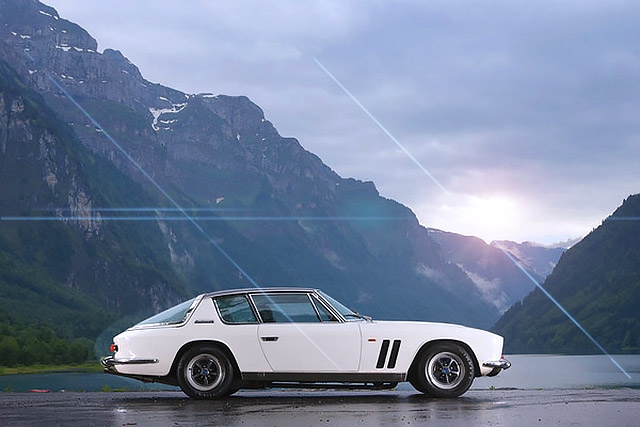
At a glance: Unique four-wheel-drive GT. Big, lazy American engine gives sparkling performance. Smooth automatic transmission, slow to change down. Almost unlimited traction and incredible roadholding from Ferguson 4-wd system. Anti-lock braking not yet perfect. Well equipped and comfortable four-seater.
Advertised as “the world’s most advanced car” and with a price tag slightly more than £6,000, the Jensen FF seems formidable at first acquaintance. Its 16ft length and angular Italian styling make it impressive (to say the least) as it sits by the kerb, and the deep throb of its 6.3-litre vee-8 engine suggests there is power to spare. In themselves, these qualities are not so unusual; but under the skin there is something much more, something unique that makes this the safest high performance car available today: four-wheel drive and anti-lock braking.
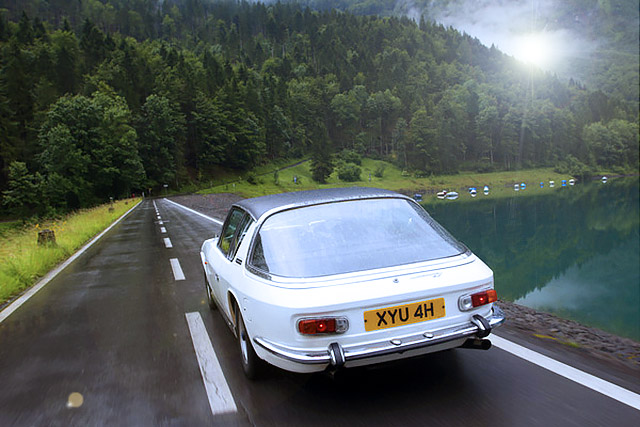
When we first drove the Oldsmobile Toronado we were apprehensive about how a large American car would behave with front-wheel drive. We were surprised at how much earlier the 500Ib ft of torque could be applied in a bend and how controllable, and therefore safe, the Toronado was. Steering the Jensen FF into a corner is uncanny, because the car seems to pull itself round with a combination of all the best front-drive and rear-drive characteristics. It is as much in advance of the Toronado as the Toronado is ahead of the rear-drive Americans.
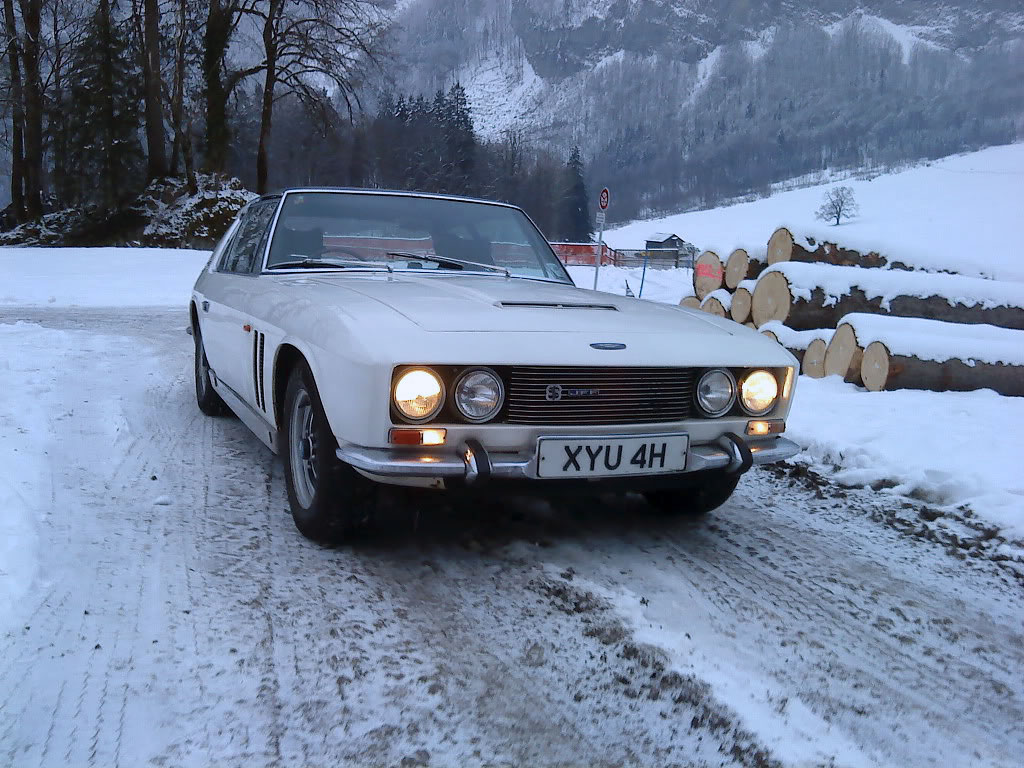
All this is the natural result of transmitting drive to all the wheels, but if it were as simple as just that there would be far more four-wheel drive cars in production. Ferguson Research have taken many, many years to develop the split-torque system to the present state where it is sufficiently viable for Jensen to put it into production and for a converted Ford Mustang to be under active assessment for police work by the Swedish Government. After almost 3,000 miles of testing in England and on the Continent, we feel the Ferguson Formula four-wheel drive gives the Jensen a tremendous advantage.
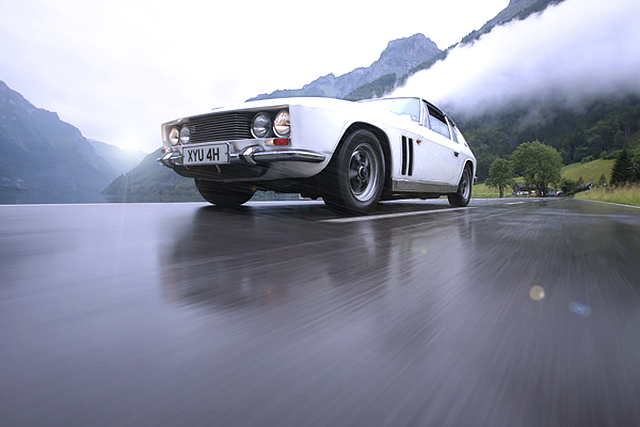
To recap on the fundamentals, the FF has a tubular chassis welded to its steel-panelled body, with a live rear axle and double-wishbone front suspension. The engine and automatic gearbox come from Chrysler and the integrated all-disc anti-lock braking system has been developed by Ferguson Research and is made jointly by Dunlop and Girling. At the back of the gearbox is a differential which splits the torque in a ratio of 37: 63 per cent between the front and rear wheels. There is a standard Salisbury rear axle and at the front a chassis-mounted differential with double-jointed drive shafts; the front propeller shaft passes along the left-hand side of the engine and gearbox.
Just over a year ago we tested the two-wheel drive Jensen Interceptor, which is exactly the same as the FF except that it has no four-wheel drive and is therefore a little shorter in the wheelbase. This was a truly dynamic car with a top speed of 133mph and a 0 to 100mph acceleration time of only 19 sec. With extra gears to churn, the FF loses a little of this performance, but not much. Maximum speed was again identical in both directions, at exactly 130mph, and 0 to 100mph took 22.5 sec.
While the FF may lose a bit in a straight line on a dry road, it more than makes up for this on twists and turns or if there is any rain about. After a dry day in the Midlands we drove back to London where there had just been a heavy shower and the streets were in that ultra- greasy state which causes unexpected skids and a lot of crumpled wings. As one set of traffic lights turned green, we gingerly opened the first pair of carburettor butterflies, expecting wheelspin and possibly some snaking, but the FF simply surged forward as if the road were dry. At the next lights we gave it full throttle and the same thing happened; it was impossible to spin the wheels.
A few days later, we were trying the car on fresh snow in Switzerland, still equipped with ordinary cross-ply Dunlop RS5 high-speed tyres at normal pressures. During a standing start with full power, the rear wheels and the right front one would just spin for a moment, but there was enough traction to climb a 1-in-4 nursery ski slope to the total amazement of the piste patrol. Only the rear differential has a Power-Lock mechanism and there is enough lateral torque reaction, at the front when accelerating hard to give the left wheel grip.
All Wheel Control
Cornering the Jensen fast is terribly easy because it seems to steer itself round every turn, exactly on line. Initially the front tyres scrub a bit, particularly on a light throttle, but often this is because the driver has put the lock on too suddenly thinking there would be some understeer. The power-assisted steering takes a little getting used to; it is light and very sensitive with just the right degree of feed-back from the road surface.
Driving to one’s accustomed standards, there is always a tremendous margin of spare cornering power in hand. As the dramatic picture we published three weeks ago showed so well, it looks as if the tyres would pull off the rims of the wheels before the car lost its grip on a dry road. In the wet there may be slightly greater slip angles front and rear, but the balance remains the same and still the FF just goes round each corner on line.
{gallery}Jensen-FF{/gallery}
Harking back to the test of the Interceptor, we commented on how well the driver could sense when it would be safe to apply full power without generating a tail slide. With the FF he can floor the accelerator as he enters a blind curve and know the front will always pull in as tightly as required and the back will simply follow round without hanging out. When one becomes used to these characteristics, it is possible to storm along twisty roads at seemingly impossible speeds, barely lifting for the kinks and bends. Passengers though, need breaking in gently to the new phenomenon, or they are liable to become alarmed.
Eventually, and only on snow, we reached the limits of adhesion for the FF. With more torque to transmit, and without enough grip to give full weight transference rearwards, it is the tail of the car which slides first. Smoothly and progressively the rear ends swings out, in just the same way as a conventional rear-wheel-drive car would at a much slower speed. The difference, and it is a big one, comes in the correction: because the front wheels are pulling as well as steering, opposite lock is much more effective and the FF straightens up with a quicker response than we have ever experienced.
PERFORMANCE SUMMARY
Mean maximum speed 130mph
Standing start 1/4-mile 15.9sec
0-60 mph 8.4 sec
30-70 mph (through gears) 7.7 sec
Typical fuel consumption 14 mpg
Miles per tankful 224
While we are fully converted to the advantages of four-wheel drive, we must retain our reservations about the Maxaret anti-lock braking system. The way this works is to sense as soon as the wheels are about to lock (and with four-wheel drive they can lock only together) and reverse the action of the vacuum servo to reduce the pressure in the hydraulic lines. Because the servo works directly as assistance to the pedal, the driver feels this action as a firm kicking-back under his foot. Our presso-meter leapt from 60 to 180lb during this cycling.
With the non-Maxaret Interceptor we obtained a maximum retardation on a dry road of 0.9g and we were able to repeat this figure on the FF merely by standing on the pedal and letting the mechanism do its work. With practice on the Interceptor, a skilled driver could hold this g figure for the whole of his stop, whereas on the FF there is nothing he can do but leave himself in the hands of the unit, which pulsates down from this peak and back again. The cycling rate is quite slow, about two or three times a second, which has the advantage of giving better steering control — while the wheels are unlocked — during emergency braking.
On wet roads the pedal kicks back at much lower pressures, because the wheels try to lock earlier. We never achieved the claimed cycling rate of five or six per second though, and we felt the system responses were too slow.
Two or three times the brake pedal kicked back at us without apparent reason when we were braking only gently from high speed. Psychologically it is disturbing to have automatic control take over in a panic situation such as a crash stop, even though the system may be bringing the car to rest in a shorter distance. On this last point we are not yet convinced, and we look forward to carrying out some further more elaborate braking tests at an early opportunity.
Luxury interior
The rest of the FF is well up to what one has a right to expect for the price. Inside there is sweet smelling Connolly hide; a twin-speaker radio with electric aerial is standard. Windows drop and lift by electric motors and there is an impressive, but not very tidy, array of instruments and switches. On the back window is a new type of heating element which is applied to the inner surface and effectively prevents misting up. It cannot cope with frost or snow on the outside though, – since toughened glass is too good a-thermal insulator.
Although the heating and ventilating system is comprehensive, with separate hot and cold air ducting, it lacks temperature sensitivity and the short levers poking through the central console panel are stiff to adjust. There is a two- speed booster fan for the hot-air system and a separate single-speed fan for the Cold-air inlets, which take the form of adjustable nozzles in the centre and at each end of the facia.
Surprisingly, there is no ignition warning lamp and the indicator tell-tales are too dim and almost hidden under the edge of the padding between the speedometer and rev counter. The horns are far too polite and melodious for a high performance GT, and they do not carry at speed.
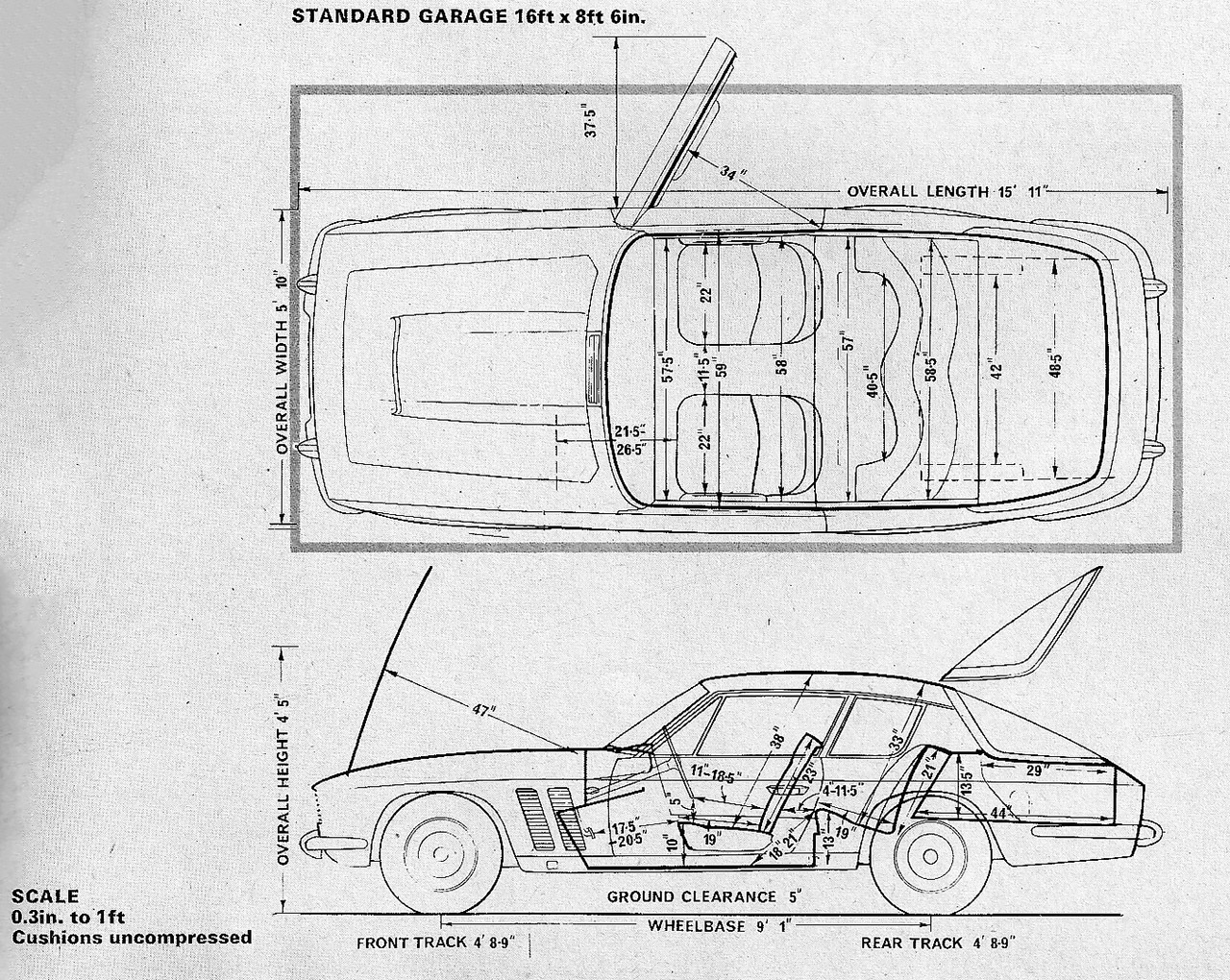
Seating is very comfortable, although it is a bit of a struggle to climb in behind the wheel, especially when another car or a wall prevents the wide door from opening fully. Backrest angle can be adjusted and the steering column telescopes to suit different arm lengths and different driving attitudes. Back seats are well shaped, but the limited dimensions here prevent one getting really comfortable.
All too often high speed cars are reduced to a crawl at night because of poor lighting equipment. In our Interceptor test we criticized the four headlamp system and suggested iodine vapour units. These are now standard on both Jensen models, and Lucas are to be congratulated on supplying by far the best set of lamps we have driven behind. Even on dipped beams it is possible to sustain very high speeds in the dark with confidence, and on main beams it is just as though the road ahead is flood-lit.
We have purposely concentrated in this test on the peculiar aspects of the four-wheel drive. The engine and transmission performed faultlessly, although we would have liked less delay in the manual over-ride mechanism. Noise levels were very low, and the FF makes no more fuss at 120 mph than it does around town. On the Continent it is truly a grand touring car with a huge appetite for gobbling up the miles, hundreds at a time. In England it is a relaxing car, which gets you there much earlier than you expect. Somehow the big, lazy engine and supreme cornering security with automatic gears and power steering take all the work out of driving and bring back much of the pleasure, despite restrictions and congestion.
Traction on fresh snow is incredibly good, on wet roads, wheel spin is impossible despite cross-ply tyres and 425lb ft of torque
1. Front seat backrests have reclining adjustment and tip forward for access to rear compartment
2. The four headlamps all have iodine vapour bulbs and give magnificent night driving illumination
3. Boot lid incorporates the wrapround rear window and reveals a really spacious carpeted compartment
4. Four-wheel drive aids handling on dry roads as well as wet
5. Well contoured rear seats give excellent location and are comfortable for adults in spite of some restriction on leg room
Steering universal joint and rubber gaiter round front drive shaft can be seen just ahead of the alternator
The compartment is not too crowded, but access to sparking plugs is difficult
Luxurious aircraft-type interior, with minor switches and controls on centre console
MANUFACTURER Jensen Motors Ltd., West Bromwich, Staffordshire.
PRICES (1968)
Basic £4,707 15s Od
Purchase Tax £1,309 15s 10d
Total (in G.B.) £6,017 10s 10d
EXTRAS (inc. PT)
Cibie quartz-iodine fog lamps (fitted) £19 14s 8d
CAR SPECIFICATIONS
| Car | 1968 Jensen FF MkI |
|
Made in |
GB |
|
ENGINE |
|
|
Cylinders Main bearings Cooling system Bore Stroke Displacement Valve gear Compression ratio Carburettor Fuel pump Oil filter Max. power Max. torque |
8, in 90-deg vee 5 Water; pump, thermostat and two electric fans 108mm (4.25in.) 86mm (3.38in.) 6.276c.c (383 cu.in.) Overhead, hydraulic tappets 10-to-1 : Min. octane rating: 100 RM Carter 4-barrel progressive Carter mechanical Mopar full flow, renewable element 325 bhp (gross) at 4,600 rpm 425 Ib.ft (gross) at 2,800 rpm |
|
TRANSMISSION |
|
|
Gearbox |
Chrysler Torque-Flite Hi-performance 3-speed automatic with torque converter |
|
Gearratios |
Top 1.0-2.20 Inter 1.45-3.19 Low 2.45-5.39 Reverse 2.20-4.84 |
|
Final drive |
Hypoid bevel with Powr-Lok limited slip differential at rear only, 3.07-to-1 |
|
CHASSIS AND BODY |
|
|
Construction |
Steel body and tubular frame welded together |
|
SUSPENSION |
|
|
Front |
Independent, twin coil springs, and telescopic dampers, wishbones, anti-roll bar |
|
Rear |
Live axle, dual-rate half-elliptic leaf springs, Panhard rod, Armstrong Selectaride adjustable telescopic dampers |
|
STEERING |
|
|
Type |
Adwest power-assisted rack and pinion |
|
Wheel dia |
17in |
|
BRAKES |
|
|
Make and type |
Girling discs front and rear, divided hydraulic circuits, Dunlop Maxaret anti-lock system incorporated (pre ABS system) |
|
Servo |
Vacuum |
|
Dimensions |
F. 11.38in. dia.; R. 10.75in. dia. |
|
Swept area |
F. 237.2 sq.in.; R. 197.4 sq.in. Total 434.6 sq.in. (221 sq.in./ton laden) |
|
WHEELS |
|
|
Type |
Pressed steel disc, chromium plated and pierced, 5in. wide rim |
|
Tyres make |
Dunlop |
|
type |
RS5 cross-ply tubed |
|
size |
6.70-15in. |
|
EQUIPMENT |
|
|
Battery |
12 volt 67 Ah |
|
Alternator |
40-amp a.c. |
|
Headlamps |
Lucas 4-lamp iodine vapour 110/220-wait (total) |
|
Reversing lamp |
2 standard |
|
Electric fuses |
5 |
|
Screen wipers |
2-speed, self-parking |
|
Screen washer |
Standard, electric |
|
Interior heater |
Standard, water-valve type |
|
Heated backlight |
Standard |
|
Safety belts |
Standard |
|
Interior trim |
Leather seats, pvc headlining |
|
Floor covering |
Wilton carpet |
|
Starting handle |
No provision |
|
Jack |
Bevelift |
|
Jacking points |
2 each side under sills |
|
Windscreen |
Laminated |
|
Underbody protection |
Bitumastic compound on all surfaces exposed to road |
|
MAINTENANCE |
|
|
Fuel tank |
16 lmp gallons (no reserve) (73 litres) |
|
Cooling system |
32 pints |
|
Engine sump |
8.5 pints (4.7 litres) SAE 20W/40. Change oil every 4,000 miles. Change filter element every 8,000 miles. |
|
Gearbox |
17 pints ATF type A. No change needed |
|
Centre and front differentials (each) |
3 pints SAE 90EP. Change oil every 12,000 miles |
|
Final drive |
3 pints Shell Limited Slip Diff. oil S6721A Change oil every 12,000 miles. |
|
Grease |
3 points every 4,000 miles |
|
Tyre pressures |
F. 24; R. 23 p.s.i. (normal driving) F. 30; R. 36 p.s.i. (short bursts to 110 mph) F. 36; R. 40 p.s.i. (sustained 110 mph and above) |
|
Maximum load |
750lb (341kg) |
|
PERFORMANCE DATA |
|
|
Top gear mph per 1,000 rpm |
25.6 |
|
Mean piston speed at max. power |
2.600ft/min |
|
Bhp per ton laden (gross) |
165.3 |
DRIVE-MY TEST RESULTS
|
Load |
g |
Distance |
|
20lb |
0.28 |
107ft |
|
40lb |
0.65 |
46ft |
|
50lb |
0.83 |
36ft |
|
60lb |
0.90 |
33.4ft |
|
Handbrake max gradient 1 in 4 |
0.40 |
75ft |
TEST CONDITIONS
Weather: Cloudy, fine. Wind: 0-5 mph. Temperature: 0 deg. C. (32 deg F). Barometer 29.3in. Hg. Humidity: 78 per cent. Surfaces: Dry concrete and asphalt.
WEIGHT
Kerb weight 35.7cwt (3,981lb – 1,806kg) (with oil, water and half-full fuel tank).
Distribution, per cent F, 52.5; R, 47.5. Laden as tested: 39.3cwt (4,403lb – 1,998kg).
|
TIME IN SECONDS |
3.1 |
4.4 |
6.2 |
8.4 |
10.8 |
13.8 |
17.5 |
22.5 |
28.2 |
37.2 |
44.3 |
|
TRUE SPEED MPH |
30 |
40 |
50 |
60 |
70 |
80 |
90 |
100 |
110 |
120 |
130 |
|
INDICATED SPEED MPH |
31 |
42 |
52 |
63 |
73 |
83 |
94 |
104 |
115 |
126 |
136 |
TURNING CIRCLES
Between kerbs L, 39ft 10in.; R, 39ft 4.5in.
Between walls L, 41ft 8.5in.; R, 41ft l in.
Steering wheel turns, lock to lock 3.6
Figures taken at 8,000 miles by our own staff at the Motor Industry Research Association proving ground at Nuneaton and on the continent.
Standing 1/4-mile 15.9sec 86mph
Standing Kilometre 29.3sec 111mph
|
Gear |
mph |
kph |
rpm |
|
Top (mean) |
130 |
209 |
5,080 |
|
(best) |
130 |
209 |
5,080 |
|
Intermediate |
88 |
142 |
5,000 |
|
Low |
52 |
84 |
5,000 |
Mileage recorder 1.7 per cent over-reading.
Test distance 2,922 miles.
|
SPEED RANGE GEAR RATIOS AND TIME IN SECONDS |
|||
|
Top 3 |
Inter 2 |
Low 1 |
|
|
mph |
(3.07-6.76) |
(4.45-9.79) |
(7.52-16.55) |
|
10-30 |
— |
— |
2.2 |
|
20-40 |
— |
— |
2.6 |
|
30-50 |
4.8 |
3.8 |
3.2 |
|
40-60 |
5.6 |
3.8 |
— |
|
50-70 |
6.3 |
4.6 |
— |
|
60-80 |
6.9 |
5.0 |
— |
|
70-90 |
7.3 |
5.5 |
— |
|
80-100 |
8.3 |
6.5 |
— |
|
90-110 |
10.7 |
— |
— |
|
100-120 |
15.1 |
— |
— |
|
FUEL |
(At constant speeds — mpg) |
||
|
30 mph 40 mph 50 mph 60 mph 70 mph 80 mph 90 mph 100 mph |
21.9 23.0 20.6 19.3 16.6 14.8 13.1 11.5 |
||
|
Typical mpg Calculated (DIN) mpg Overall mpg Grade of fuel |
14 (20.2 litres/100km) 15.1 (18.7 litres/100km) 13.6 (20.8 litres/100km) Super Premium, 5-star (min 100 RM) |
||
|
OIL Miles per pint (SAE 20W/40) |
600 |
||





